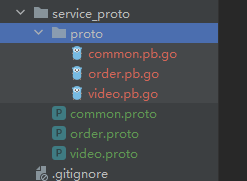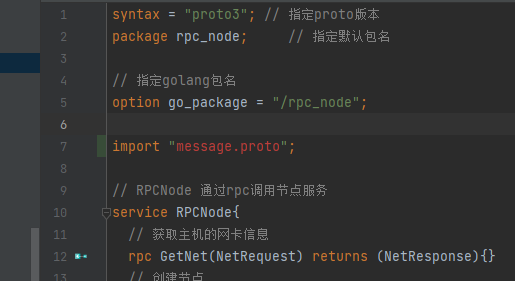syntax = "proto3"; // 指定proto版本
package hello_grpc; // 指定默认包名
// 指定golang包名
option go_package = "/hello_grpc";
//定义rpc服务
service HelloService {
// 定义函数
rpc SayHello (HelloRequest) returns (HelloResponse) {}
}
// HelloRequest 请求内容
message HelloRequest {
string name = 1; // 消息号
string message = 2;
}
// HelloResponse 响应内容
message HelloResponse{
string name = 1;
string message = 2;
}
生成go文件
option go_package = ".;xxx";
go_package 表示在当前目录生成go文件,文件的包名是xxx
protoc -I . --go_out=plugins=grpc:./grpc_proto .\grpc_proto\hello.proto
proto文件只是定义接口方法
proto语法
service 对应的就是go里面的接口,可以作为服务端,客户端
rpc 对应的就是结构体中的方法
message对应的也是结构体
数据类型
基本数据类型
message Request {
double a1 = 1;
float a2 = 2;
int32 a3 = 3;
uint32 a4 = 4;
uint64 a5 = 5;
sint32 a6 = 6;
sint64 a7 = 7;
fixed32 a8 = 8;
fixed64 a9 = 9;
sfixed32 a10 = 10;
sfixed64 a11 = 11;
bool a12 = 12;
string a13 = 13;
bytes a14 = 14;
}
对应go类型
type Request struct {
state protoimpl.MessageState
sizeCache protoimpl.SizeCache
unknownFields protoimpl.UnknownFields
A1 float64 `protobuf:"fixed64,1,opt,name=a1,proto3" json:"a1,omitempty"`
A2 float32 `protobuf:"fixed32,2,opt,name=a2,proto3" json:"a2,omitempty"`
A3 int32 `protobuf:"varint,3,opt,name=a3,proto3" json:"a3,omitempty"`
A4 uint32 `protobuf:"varint,4,opt,name=a4,proto3" json:"a4,omitempty"`
A5 uint64 `protobuf:"varint,5,opt,name=a5,proto3" json:"a5,omitempty"`
A6 int32 `protobuf:"zigzag32,6,opt,name=a6,proto3" json:"a6,omitempty"`
A7 int64 `protobuf:"zigzag64,7,opt,name=a7,proto3" json:"a7,omitempty"`
A8 uint32 `protobuf:"fixed32,8,opt,name=a8,proto3" json:"a8,omitempty"`
A9 uint64 `protobuf:"fixed64,9,opt,name=a9,proto3" json:"a9,omitempty"`
A10 int32 `protobuf:"fixed32,10,opt,name=a10,proto3" json:"a10,omitempty"`
A11 int64 `protobuf:"fixed64,11,opt,name=a11,proto3" json:"a11,omitempty"`
A12 bool `protobuf:"varint,12,opt,name=a12,proto3" json:"a12,omitempty"`
A13 string `protobuf:"bytes,13,opt,name=a13,proto3" json:"a13,omitempty"`
A14 []byte `protobuf:"bytes,14,opt,name=a14,proto3" json:"a14,omitempty"`
}
标量类型
| .proto Type | 解释 | Go Type |
|---|---|---|
| double | float64 | |
| float | float32 | |
| int32 | 使用变长编码,对于负值的效率很低,如果你的域有可能有负值,请使用sint64替代 | int32 |
| uint32 | 使用变长编码 | uint32 |
| uint64 | 使用变长编码 | uint64 |
| sint32 | 使用变长编码,这些编码在负值时比int32高效的多 | int32 |
| sint64 | 使用变长编码,有符号的整型值。编码时比通常的int64高效 | int64 |
| fixed32 | 总是4个字节,如果数值总是比总是比228大的话,这个类型会比uint32高效。 | uint32 |
| fixed64 | 总是8个字节,如果数值总是比总是比256大的话,这个类型会比uint64高效。 | uint64 |
| sfixed32 | 总是4个字节 | int32 |
| sfixed64 | 总是8个字节 | int64 |
| bool | bool | |
| string | 一个字符串必须是UTF-8编码或者7-bit ASCII编码的文本 | string |
| bytes | 可能包含任意顺序的字节数据 | []byte |
标量类型如果没有被赋值,则不会被序列化,解析时,会赋予默认值
- strings:空字符串
- bytes:空序列
- bools:false
- 数值类型:0
数组类型
message ArrayRequest {
repeated int64 a1 = 1;
repeated string a2 = 2;
repeated Request request_list = 3;
}
go类型
type ArrayRequest struct {
A1 []int64
A2 []string
RequestList []*Request
}
map类型
键只能是基本类型
message MapRequest {
map<int64, string> m_i_s = 1;
map<string, bool> m_i_b = 2;
map<string, ArrayRequest> m_i_arr = 3;
}
go类型
type MapRequest struct {
MIS map[int64]string
MIB map[string]bool
MIArr map[string]*ArrayRequest
}
嵌套类型
message Q1 {
message Q2{
string name2 = 2;
}
string name1 = 1;
Q2 q2 = 2;
}
type Q1 struct {
state protoimpl.MessageState
sizeCache protoimpl.SizeCache
unknownFields protoimpl.UnknownFields
Name1 string `protobuf:"bytes,1,opt,name=name1,proto3" json:"name1,omitempty"`
Q2 *Q1_Q2 `protobuf:"bytes,2,opt,name=q2,proto3" json:"q2,omitempty"`
}
编写风格
- 文件名建议下划线,例如:my_student.proto
- 包名和目录名对应
- 服务名、方法名、消息名均为大驼峰
- 字段名为下划线
多服务
syntax = "proto3"; // 指定proto版本
// 指定golang包名
option go_package = "/duo_proto";
service VideoService {
rpc Look(Request)returns(Response){}
}
message Request{
string name = 1;
}
message Response{
string name = 1;
}
service OrderService {
rpc Buy(Request)returns(Response){}
}
服务端
package main
import (
"context"
"fmt"
"google.golang.org/grpc"
"grpc_study/grpc_proto/duo_proto"
"log"
"net"
)
type VideoServer struct {
}
func (VideoServer) Look(ctx context.Context, request *duo_proto.Request) (res *duo_proto.Response, err error) {
fmt.Println("video:", request)
return &duo_proto.Response{
Name: "fengfeng",
}, nil
}
type OrderServer struct {
}
func (OrderServer) Buy(ctx context.Context, request *duo_proto.Request) (res *duo_proto.Response, err error) {
fmt.Println("order:", request)
return &duo_proto.Response{
Name: "fengfeng",
}, nil
}
func main() {
listen, err := net.Listen("tcp", ":8080")
if err != nil {
log.Fatal(err)
}
s := grpc.NewServer()
duo_proto.RegisterVideoServiceServer(s, &VideoServer{})
duo_proto.RegisterOrderServiceServer(s, &OrderServer{})
fmt.Println("grpc server程序运行在:8080")
err = s.Serve(listen)
}
客户端
package main
import (
"context"
"fmt"
"google.golang.org/grpc"
"google.golang.org/grpc/credentials/insecure"
"grpc_study/grpc_proto/duo_proto"
"log"
)
func main() {
addr := ":8080"
// 使用 grpc.Dial 创建一个到指定地址的 gRPC 连接。
// 此处使用不安全的证书来实现 SSL/TLS 连接
conn, err := grpc.Dial(addr, grpc.WithTransportCredentials(insecure.NewCredentials()))
if err != nil {
log.Fatalf(fmt.Sprintf("grpc connect addr [%s] 连接失败 %s", addr, err))
}
defer conn.Close()
orderClient := duo_proto.NewOrderServiceClient(conn)
res, err := orderClient.Buy(context.Background(), &duo_proto.Request{
Name: "枫枫",
})
fmt.Println(res, err)
videoClient := duo_proto.NewVideoServiceClient(conn)
res, err = videoClient.Look(context.Background(), &duo_proto.Request{
Name: "枫枫",
})
fmt.Println(res, err)
}
多个proto文件
当项目大起来之后,会有很多个service,rpc,message
我们会将不同服务放在不同的proto文件中
还可以放一些公共的proto文件
对于这方面的资料,可以说全网的正确资料真的相当少
其实本质就是生成go文件,需要在一个包内

video.proto
syntax = "proto3";
package proto1;
option go_package = "/proto";
import "common.proto";
service VideoService {
rpc Look(Request)returns(Response){}
}
order.proto
syntax = "proto3";
package proto;
option go_package = "/proto";
import "common.proto";
service OrderService {
rpc Look(Request)returns(Response){}
}
common.proto
syntax = "proto3";
package proto;
option go_package = "/proto";
message Request{
string name = 1;
}
message Response{
string name = 1;
}
生成命令
protoc -I .\service_proto --go_out=plugins=grpc:./service_proto .\service_proto\order.proto
protoc -I .\service_proto --go_out=plugins=grpc:./service_proto .\service_proto\video.proto
protoc -I .\service_proto --go_out=plugins=grpc:./service_proto .\service_proto\common.proto
有几个点需要注意
如果有import的话,必须得加上package
并且要和import的package相同
使用,还是和之前一样使用
服务端
package main
import (
"context"
"fmt"
"google.golang.org/grpc"
"grpc_study/service_proto/proto"
"log"
"net"
)
type VideoServer struct {
}
func (VideoServer) Look(ctx context.Context, request *proto.Request) (res *proto.Response, err error) {
fmt.Println("video:", request)
return &proto.Response{
Name: "fengfeng",
}, nil
}
type OrderServer struct {
}
func (OrderServer) Look(ctx context.Context, request *proto.Request) (res *proto.Response, err error) {
fmt.Println("order:", request)
return &proto.Response{
Name: "fengfeng",
}, nil
}
func main() {
listen, err := net.Listen("tcp", ":8080")
if err != nil {
log.Fatal(err)
}
s := grpc.NewServer()
proto.RegisterVideoServiceServer(s, &VideoServer{})
proto.RegisterOrderServiceServer(s, &OrderServer{})
fmt.Println("grpc server程序运行在:8080")
err = s.Serve(listen)
}
客户端
package main
import (
"context"
"fmt"
"google.golang.org/grpc"
"google.golang.org/grpc/credentials/insecure"
"grpc_study/service_proto/proto"
"log"
)
func main() {
addr := ":8080"
// 使用 grpc.Dial 创建一个到指定地址的 gRPC 连接。
// 此处使用不安全的证书来实现 SSL/TLS 连接
conn, err := grpc.Dial(addr, grpc.WithTransportCredentials(insecure.NewCredentials()))
if err != nil {
log.Fatalf(fmt.Sprintf("grpc connect addr [%s] 连接失败 %s", addr, err))
}
defer conn.Close()
orderClient := proto.NewOrderServiceClient(conn)
res, err := orderClient.Look(context.Background(), &proto.Request{
Name: "枫枫",
})
fmt.Println(res, err)
videoClient := proto.NewVideoServiceClient(conn)
res, err = videoClient.Look(context.Background(), &proto.Request{
Name: "枫枫",
})
fmt.Println(res, err)
}
同目录,生成的不同包的proto文件
message.proto
syntax = "proto3"; // 指定proto版本
package message; // 指定默认包名
// 指定golang包名
option go_package = "work_server/rpc/message";
message Request {}
message Response {}
a.proto
syntax = "proto3"; // 指定proto版本
package rpc_node; // 指定默认包名
// 指定golang包名
option go_package = "/rpc_node";
import "message.proto";
// RPCNode 通过rpc调用节点服务
service RPCNode{
// 获取主机的网卡信息
rpc Node(message.Request) returns (message.Response){}
}
goland编辑器爆红问题
























 1053
1053

 被折叠的 条评论
为什么被折叠?
被折叠的 条评论
为什么被折叠?








